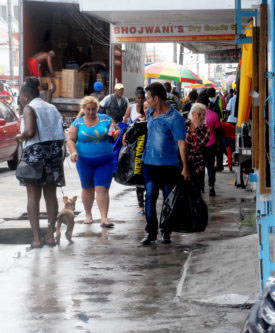There is something to be said for the sheer tenacity of what, these days, is the remaining handful of traditional high street traders who, against seemingly insurmountable odds, have survived the otherwise complete transformation of the country’s urban commercial culture, emerging intact though hardly unscathed and even retaining some of the old-fashioned customs associated with downtown trading of an earlier era.
It showed during this year’s avalanche of seasonal shopping that is now almost at and end. Those ‘old timers’ on Regent and Water streets, particularly, that manage to keep their doors open, still attract customers, albeit in smaller numbers, with items and brand names of the past, in-demand consumer goods that do not carry the Chinese trademarks that now dominate the commercial landscape. Say what you like about the all-pervasive nature of the Chinese invasion, old habits still die hard.
Christmas and the unchangeable propensity for throwing out the old and embracing the new has been the engine that has kept the hire purchase culture ticking over. The principle of instant gratification in exchange for delayed payment has long been part of the beating heart of what we call ‘the spirit of Christmas’ for working families whose whole year, frequently, culminates with the costly, short-term gratification afforded by the season. It means, as well, a windfall for trading establishments offering in-demand goods ‘on terms,’ prepared to endure delayed payment, acutely aware of the longer term and considerable profit that derives therefrom.
Christmas shopping, we were reminded this year, far transcends the mundanity of exchanging money for goods. The essence of the practice reposes, first, in the anticipation, then in the planning then the exercise itself. After you ‘hit the streets’ and become swallowed up in the bump and grind, the shove and push and the making of serious choices like those that have to do with picking new furniture to be acquired on ‘HP’ and selecting gifts for ‘picky’ family members and friends it is only then that your Christmas shopping really begins. Christmas.
The change which, these days, obtains, in the whole of the Christmas shopping culture has come over time, arising out of circumstances that have to do as much with domestic socio-economic change as with the global phenomenon over which we have little control. The pavement vendors that are now at the heart of the contemporary trading culture have survived sustained attempts to lop their heads off once they had surfaced some years ago, in the first place. They first emerged out of circumstances of acute family crisis associated with unemployment, insufficient income and the need to support families. Frankly, it took far too long for the authorities to come to terms with the reality that we were faced with a choice between embracing pavement vending as part of the local small business culture or else, find ourselves having to fend off a level of crime much worse than obtains these days.
The pavement vendors have fought and won their own battles, ‘graduating’ from the status of annoyance and humbug to a kind of legitimacy that far transcends the status of the ‘necessary evil’ which they were once perceived to be. Grudgingly, the authorities, the high street merchants and commuters as a whole, all of whom, who, at one point in time or another, had frowned on their presence, have learnt to co-exist with them. Over time too, some of the pavement vendors have so expanded their operations that they have transformed themselves into convenient alternatives to the established stores.
During the Christmas ‘crush’ you commonly found shoppers opting for the pavement vendors in their pursuit of items that could be acquired through significantly less effort than through the option of crowded stores.
Other elements of the commercial culture have changed too. The days of a handful of downtown stores and strict limitations on imported goods and expenditure constrained by affordability have long been put behind us. A more liberalized economy, greater access to US dollars and by extension, imported goods coupled with the rapid acceleration of remittances from abroad have been among contributing factors to the transformation. Remittances came along not only in the form of US dollars but also in the form of what became known as ‘the barrel trade,’ the wholescale movement of consumer items, mostly clothes and utility items, most of which were re-sold by the recipients much of it through the vehicle of pavement vending. It was the huge proliferation of the ‘barrel trade’ that triggered the emergence of a host of smaller local shipping services, some of which have grown and prospered.
Under pressure from a trading culture that was radically transforming itself it was the small ‘clan’ of high street retail vendors that had entrenched themselves over many decades, that cracked first. Some began to close their doors. On the one hand there was the challenge which they faced in acquiring foreign currency, either through a tightly controlled central bank rationing regime or through the illegal channels of clandestine acquisition on the streets, with all the risks associated therewith. That was the period during which the routines of the traditional merchants became reduced to drudgery on account of rules and restrictions that completely deformed the country’s commercial culture. It was not easy to determine that sooner or later something, for better or worse, had to emerge in place of the gulf that was developing.
The vendors came and survived because they were determined and desperate and flexible and prepared to engage the municipal authorities in a protracted battle of attrition for their survival and for the survival of their families. They were, in the main, a tough, inner city breed that had come prepared to fight. Through a mix of sheer perseverance and appeals to social conscience they fought their way towards a position resembling legitimacy, their tenacity eventually recruiting the public to their side and literally wearing down the municipal police whose inclination for corruption-driven shakedowns hopelessly undermined their credibility as a law enforcement institution. Gradually, the vendors won concessions in the form of designated trading spaces and afterwards a handful of built up shopping ‘malls.’ To their credit, they have ‘fitted in,’ managing somehow to establish a rapport with the mainstream merchants and the generous support of consumers. A significant measure of credit also attaches to pavement vending for the role it has played in creating pockets of more orthodox entrepreneurship some of which has grown and prospered.
The real Shopping Malls, the multi-storied edifices eventually appeared.
Mimic
They sought to mimic rather than match what obtained in the metropolis, marking a partial transformation in the manner in which our urban trading culture presented itself. First, they provided modern spaces that attracted investment in vending that rose above the level of the pavement. At the same time they facilitated the significant expansion of the substantive retail trade beyond that which was being offered by the High Street merchants. Shopping Malls were more than just places to purchase goods. They were new and exceptional spaces with ‘trimmings’ that included restaurants, music and various other creature comforts. To a significant extent Shopping Malls have played a role in altering the behavioural culture among Guyanese. Malls served as well to provide further competition for the remaining small downtown stores, their further weakening softening them up for the subsequent Chinese commercial invasion that was to come.
These days, it is the Chinese that have thrown down a robust commercial gauntlet in the capital with their huge investments in the best High Street trading spaces, their wholesale importation of more affordable consumer goods and their aggressive assimilation into the Guyanese trading culture. Their offerings, as much in terms of fashion items as utility goods have created an irresistible local demand, their most recent trading triumph being the quiet capture of the market for consumer goods amongst heavy-spending Cubans whose presence here have now become a way of commercial life. Unquestionably, the arrival of the contemporary Chinese traders has created the most significant trading transformation in the contemporary history of Guyana.
Our commercial culture is an evolving phenomenon and it is hard to say where it will lead. The changes, however, have been as distinct as they have been profound though change has not been able to kill off altogether those elements of the past, not least the traditional merchants and their cramped stores packed with goods that remain marketable notwithstanding the advent of competing and upgraded brands. Old habits and patterns of customer confidence are tough to change and people still continue to ‘chase’ brands that have traditionally served them well. In downtown, old-fashioned High street stores, Salesgirls still follow discomfittingly in the footsteps of shoppers (the Chinese merchants appeared to have embraced the habit enthusiastically) so that if you are self-conscious you quickly develop a feeling of ‘being watched;’ the salesgirls still try to press you into making up your mind and the final financial transaction is still superintended by the store owner or some highly trusted functionary who, in some cases, still relies on the services of an antiquated calculator. In that environment, the more things have changed the more they have remained the same.








